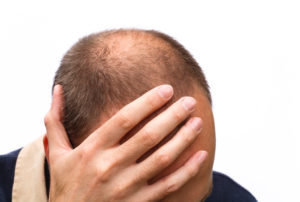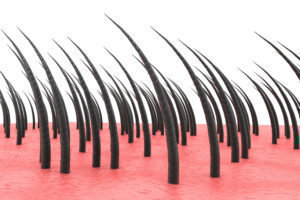Using Finasteride When Trying To Conceive
Short facts about hair loss and finasteride
- Hair plays a vital role in both men and women’s appearance and helps to transmit sensory information.
- An adult has about 100,000 to 150,000 hairs and loses up to 100 hairs a day.
- The scalp hair grows approximately 0.35 mm per day.
- Hair is composed of two different structures the hair follicle which resides in the skin, and second, the shaft, which is visible above the scalp.
- Hair growth has three stages of growth and shedding: the anagen phase, the catagen phase and the telogen phase.
- During intrauterine life, approximately 5 million hair follicles are developed on the body.
- By week 22, a developing fetus has all its hair follicles formed.
- No follicles are formed after birth.
- Androgenetic alopecia is commonly called male or female pattern baldness.
- The hair follicles affected by androgenetic alopecia are permanently damaged and any hair loss, as a result, is irreversible.
- Finasteride belongs to type II ‘5-alpha reductase inhibitors.
- Finasteride has no effect in women hair loss.
- Finasteride 1 mg is indicated in the treatment of male pattern hair loss.
- Finasteride 5 mg is indicated in the treatment and control of benign prostatic hyperplasia.

The structure of hair
Hair plays a vital role in the appearance of both men and women and is involved in transmitting sensory information and gender identification.
Hair grows everywhere on the human skin except on the palms and the soles, but many hairs are so fine they are virtually invisible.
A total number of 5 million hair follicles are developed in the body during the intrauterine life. One million of the follicles are present on the head, and one hundred thousand of those follicles residing on the scalp. This is the largest number of hair follicles a human will ever have. No more new hair follicles will be generated during our lives.
The hair is composed of two different structures:
- The hair follicle which resides in the skin;
- The shaft, which is visible above the scalp.
The hair follicle is a tunnel-like segment of the epidermis and it extends down into the dermis. Its structure contains several layers, each layer having a separate function:
- Papilla: contains capillaries or tiny blood vessels that nourish the cells.
- The bulb: represents the living part of the hair; the cells of the bulb divide every 23 to 72 hours, remarkably faster than any other cell in the body.
- Two sheaths, an inner and outer sheath: surround the follicle and protect and form the hair shaft. The inner sheath follows the hair shaft and ends below the opening of a sebaceous (oil) gland, and sometimes an apocrine gland, while the outer sheath continues all way up to gland.
The hair shaft is composed of a hard protein called keratin that is produced in hair follicles in the outer layer of skin. Being a water-insoluble protein, keratin ensures the impermeability and the protection of the hair. The hair shaft is made of three layers:
- Medulla (the inner layer);
- Cortex (the second layer): it makes up most of the hair shaft. It contains melanin, the pigment that gives the hair colour. The cells responsible with melanin production no long produce melanin in old persons. This is the reason why, as we get older, our hair becomes grey or white. The cortex contains also the proteins which express the shape of the hair, curly or straight.
- Cuticle (the outer layer). It is the outermost part of the hair shaft and it is protected by the sebum.
Causes of hair loss
Hair loss is typically related to one or more of the following factors:
- Family history (heredity) is the most common cause of hair loss and it usually occurs gradually with ageing and in predictable patterns — a receding hairline and bald spots in men and thinning hair in women;
- Hormones, such as abnormal levels of androgens;
- Stress;
- Illness;
- Childbirth;
- Drugs, including chemotherapy drugs used in cancer treatment, blood thinners, beta-adrenergic blockers used to control blood pressure, and birth control pills;
- Burns, injuries, and X-rays can cause temporary hair loss. In such cases, normal hair growth usually returns once the injury heals unless a scar is produced. Then, hair will never re-grow;
- Autoimmune diseases;
- Cosmetic procedures, such as shampooing too often, perms, bleaching, and dyeing hair can contribute to overall hair thinning by making hair weak and brittle. Tight braiding, using rollers or hot curlers, and running hair picks through tight curls can also damage and break hair. However, these procedures don’t cause baldness. In most instances, hair grows back normally if the source of the problem is removed. Still, severe damage to the hair or scalp sometimes causes permanent bald patches;
- Medical conditions like thyroid disease, lupus, diabetes, iron deficiency anaemia, eating disorders, and anaemia can cause hair loss. Most times, when the underlying condition is treated, the hair will return;
- Diet: a low-protein diet or severely calorie-restricted diet can also cause temporary hair loss.
How does finasteride work?
Finasteride is a prescription drug available as oral tablets. Finasteride can be found under brand names Proscar (5 mg tablets) and Propecia (1 mg tablets).
Finasteride belongs to the class of drugs called 5-alpha reductase inhibitors. The 5-alpha-reductase is an intracellular enzyme that converts testosterone to its active form, dihydrotestosterone (DHT). Dihydrotestosterone (DHT) is the main hormone responsible for androgenetic alopecia. This hormone leads to the occurrence of scalp hair loss by inducing a change in the hair follicles on the scalp. Also, dihydrotestosterone leads to prostate enlargement.
Finasteride formulated as 1 mg tablets are indicated in the treatment of androgenic alopecia (men only), while Finasteride 5 mg tablets are used in the treatment of benign prostatic hyperplasia.
Finasteride is a competitive and specific inhibitor of type II 5 alpha-reductase. Hair follicles contain type II 5α-reductase. In men with male pattern hair loss, the balding scalp contains miniaturised hair follicles and increased amounts of DHT. Administration of finasteride decreases scalp and serum DHT concentrations in these men. Men with a genetic deficiency of type II 5 alpha-reductase do not suffer from male pattern hair loss. Finasteride inhibits a process responsible for miniaturisation of the scalp hair follicles, which can lead to a reversal of the balding process.
Pharmacokinetics of finasteride
Absorption
Compared with an intravenous interference dose, oral bioavailability of finasteride is approximately 80%. Oral bioavailability is not influenced by food. Maximum plasma concentration of finasteride is reached approximately two hours after administration and the absorption is complete after six to eight hours.
Distribution
Finasteride binds the proteins in the proportion of approximately 93%. Its volume of distribution is approximately 76 litres. Finasteride has been recovered in the cerebrospinal fluid (CSF), but the drug does not appear to concentrate preferentially to the CSF. A small amount of finasteride has also been detected in the seminal fluid of subjects receiving the drug.
Biotransformation
Finasteride is metabolized via cytochrome P450 3A4 system to two metabolites. The metabolites were found to possess only a small fraction of the 5-alpha-reductase inhibitory activity of finasteride.
Elimination
Following an oral dose of finasteride in man, 39% of the dose was excreted in the urine in the form of metabolites and 57% of the total dose was excreted in the faeces. Plasma clearance is approximately 165 ml/min. The elimination rate of finasteride decreases somewhat with age. Mean terminal half-life is approximately 5-6 hours in men 18-60 years of age and 8 hours in men more than 70 years of age. These findings are of no clinical significance and hence, a reduction in dosage in the elderly is not warranted.

Is finasteride safe? What are the side effects?
Finasteride can cause side effects like any other drugs, although not everybody gets them. Some of the side effects are temporary and disappeared when treatment is stopped. The following adverse reactions have been identified during post-approval use of Finasteride:
- Hypersensitivity Reaction
- rash;
- pruritus;
- urticaria;
- angioedema (including swelling of the lips, tongue, throat, and face);
- Reproductive System:
- sexual dysfunction that continued after discontinuation of treatment;
- erectile dysfunction;
- libido disorders;
- ejaculation disorders;
- orgasm disorders;
- male infertility;
- poor seminal quality (normalization or improvement of seminal quality has been reported after discontinuation of Finasteride);
- testicular pain;
- Neoplasms:
- male breast cancer;
- Breast disorders:
- breast tenderness and enlargement;
- Nervous System/Psychiatric:
- Depression.
Stop taking Finasteride and immediately contact a doctor if you have any of the following experiences:
- Symptoms of an allergic reaction: swelling of your lips, face, tongue and throat; difficulty swallowing; lumps under your skin (hives) and breathing difficulties.
- Depression (feeling of severe sadness and unworthiness).
You should promptly report to your doctor any changes in your breast tissue such as lumps, pain, enlargement or nipple discharge as these may be signs of a serious condition, such as breast cancer.
Uncommon side effects (may affect up to 1 in 100 people) are the following:
- incapacity to have an erection (impotence);
- have less desire for having sex;
- problems with ejaculation, for example, a decrease in the amount of semen released during sex. This decrease in the amount of semen does not appear to affect normal sexual function.
Side effects with unknown frequency include:
- breast tenderness and enlargement;
- testicular pain;
- infertility;
- palpitations (heart is beating too hard or too fast);
- increased hepatic enzymes;
- persistent difficulty having an erection after discontinuation of treatment;
- persistent decrease in sex drive after discontinuation of treatment;
- persistent problems with ejaculation after discontinuation of treatment;
- male infertility and/or poor quality of semen.
Using Finasteride when trying to conceive. Is it safe to conceive a child while taking Finasteride?
According to the summary of product characteristics long-term data on fertility in humans taking finasteride are lacking, and specific studies in subfertile men have not been conducted. The male patients who were planning to father a child were initially excluded from clinical trials. Although animal studies did not show relevant negative effects on fertility, spontaneous reports of infertility and/or poor seminal quality were received post-marketing. In some of these reports, patients had other risk factors that might have contributed to infertility. Normalization or improvement of seminal quality has been reported after discontinuation of finasteride. The patient information leaflet recommends that patients who are planning to father a child should consider stopping treatment with finasteride.
Does finasteride affect spermatogenesis and pregnancy? What do the studies say?
According to several studies, there are no reports of adverse pregnancy outcomes among women exposed to finasteride. Taking 1 mg of finasteride daily did not have any clinically significant effect on men’s semen. The summary of product characteristics recommends that women who are pregnant or may become pregnant should not handle finasteride tablets especially if crushed or broken because of the possibility of absorption of finasteride and the subsequent potential risk to a male foetus. For this reason, many women become alarmed. Tablets, however, are coated with a film, so the risk of absorption of finasteride through the skin is negligible and is unlikely to cause harm to a fetus.
In one clinical study performed on 35 men taking 1 mg of finasteride daily for 6 weeks, semen levels were measured. Highest level measured was 1.52ng/mL; the mean level was 0.26ng/mL. Assuming a 100% vaginal absorption through a 5-mL ejaculate per day, women would be exposed to 7.6ng/d, a negligible amount.
The manufacturer of the drug performed several animal studies to assess the effects of finasteride on spermatogenesis and pregnancy. In one of these studies, 800ng/d of finasteride was intravenously administered to rhesus monkeys. This dose represents 750 times the highest estimated exposure of pregnant women from semen of men taking 1 mg/d. To confirm the relevance of results in rhesus monkeys for human fetal development, pregnant monkeys were administered high oral doses of finasteride (2 mg/kg/d, which is equivalent to 100 times the recommended human dose of 1 mg/d, or 12 million times the highest estimated exposure from semen of men taking 1 mg/d). Results showed abnormalities in male external genitalia, but no other abnormalities and no effect on female foetuses.
In 1999, a double-blind, randomized placebo-controlled multicentre study was conducted on 181 men between 19 and 41 years old. These men received 1 mg/d of finasteride or placebo for 48 weeks (4 spermatogenic cycles) and no drugs for the following 60 weeks. Among these
181 men, 79 were included in a subset for collection and analysis of sequential semen samples. Results showed that 1 mg/d of finasteride did not have any significant effect on sperm concentration, total sperm per ejaculate, or sperm motility or morphology.
The effects of finasteride on semen and hormone parameters
The effects of finasteride in semen and hormone parameters were assessed in one prospective clinical study. The objective of the study was to determine the degree of improvement in semen parameters after finasteride discontinuation.
Men taking finasteride who presented for a fertility evaluation from 2008–2012 at a single male infertility speciality clinic were identified via a prospectively collected database. The main outcomes were semen and hormone parameters before and after discontinuation finasteride.
The study included 4400 men aged between 26 and 54 years who are taking finasteride. The mean duration of the treatment was 57.4 months and the mean dose was 1.04 mg/day. No man had a decrease in sperm count and there was no change in hormone parameters, sperm motility, or sperm morphology.
The results of the study indicated that that finasteride is associated with subfertility in some men and that the adverse effect of finasteride is reversible for most of the men who present with infertility. We suggest that in infertile men with oligospermia or azoospermia using finasteride, even at the low dose of 1 mg for androgenic alopecia, the drug should be discontinued. The discontinuation of finasteride may not bring the sperm parameters to levels where a spontaneous pregnancy is likely, but it may lead to improvement in semen parameters that will allow for a less invasive fertility therapy (intrauterine insemination versus intracytoplasmic sperm injection). In addition, caution and appropriate counselling should be exercised when these drugs are given to men of reproductive age who desire fertility.

Warnings and precautions before taking finasteride
Finasteride should never be taken by women or children. If a woman is exposed to Finasteride during pregnancy, birth defects can be met. Finasteride tablets should not be handled by a woman who is pregnant or may become pregnant.
Before taking finasteride, tell your doctor or pharmacist if you are allergic to it or if you have any other allergies.
To be sure that finasteride is safe for you, tell your health care professional if you suffer for one of the following conditions:
- liver disease, or abnormal liver enzyme tests;
- prostate cancer;
- a bladder muscle disorder;
- stricture of your urethra;
- if you are unable to urinate;
- if you have ever had an allergic reaction to a similar medicine called dutasteride (Avodart).
References
- https://www.webmd.com/skin-problems-and-treatments/hair-loss/science-hair
- https://www.webmd.com/skin-problems-and-treatments/hair-loss/understanding-hair-loss-basics
- Springer K, Brown M, Stulberg DL. Common hair loss disorders. Am Fam Physician. 2003 Jul 1;68(1):93-102.
- https://www.webmd.com/skin-problems-and-treatments/hair-loss/science-hair
- http://www.medbroadcast.com/condition/getcondition/alopecia
- http://www.alopeciaonline.org.uk/androgeneticalopecia.asp
- Finasteride, Summary of product characteristics
- https://uk.lush.com/article/understanding-hair-structure
- https://www.mayoclinic.org/diseases-conditions/hair-loss/symptoms-causes/syc-20372926
- https://www.medicines.org.uk/emc/product/6044/pil
- Pole M, Koren G. Finasteride. Does it affect spermatogenesis and pregnancy? Can Fam Physician. 2001 Dec;47:2469-70. PubMed PMID: 11785276; PubMed Central PMCID: PMC2018472.
- Samplaski MK, Lo K, Grober E, Jarvi K. Finasteride use in the male infertility population: effects on semen and hormone parameters. Fertil Steril. 2013 Dec;100(6):1542-6. doi: 10.1016/j.fertnstert.2013.07.2000. Epub 2013 Sep 4. PubMed PMID: 24012200.

